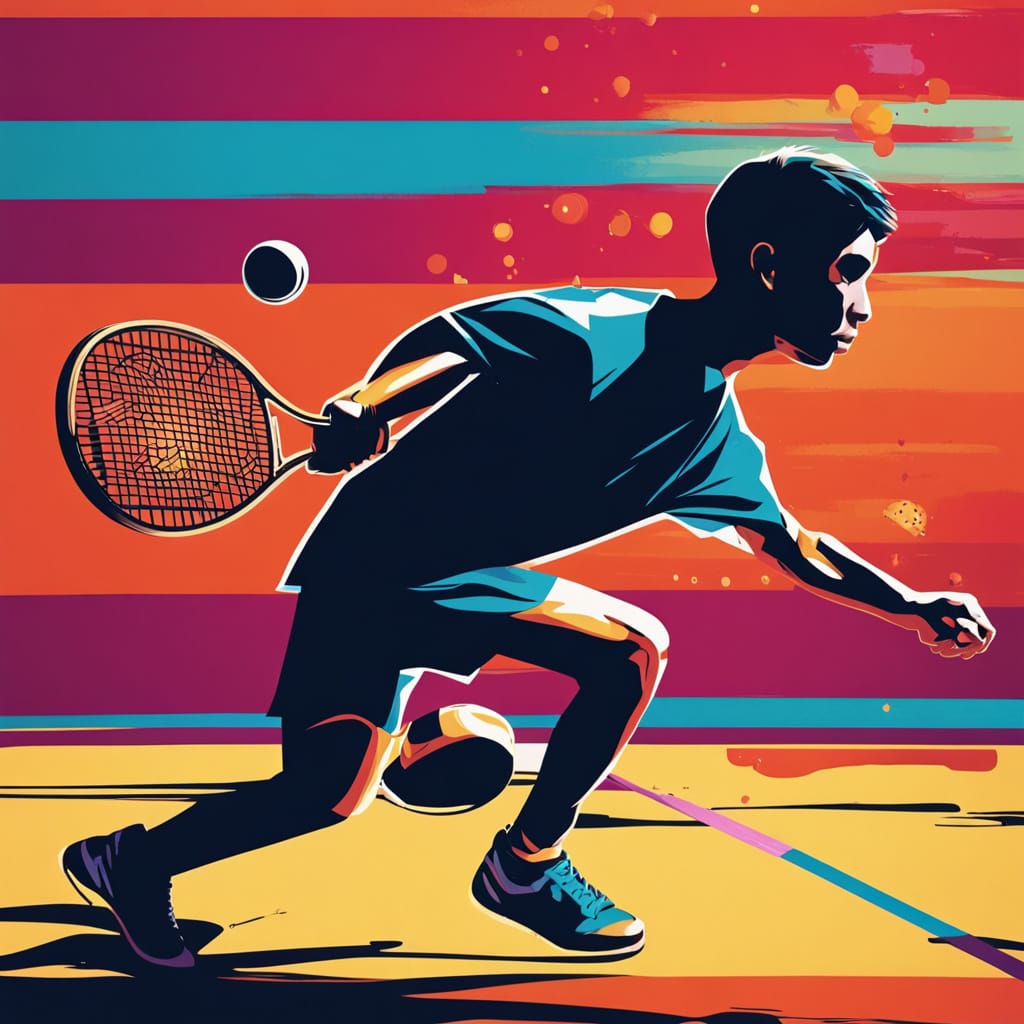The Comprehensive Guide to Racquetball: History, Popularity, and More

Racquetball is a dynamic and exciting sport that has garnered attention worldwide. Its unique combination of speed, skill, and strategy has made it a favorite among players and fans alike. In this blog post, we will explore the fascinating world of Racquetball in detail. We will cover its origin and history, global popularity, amateur play, professional leagues, political and social significance, and the essential rules of the game. By the end of this article, you will have a thorough understanding of it and its impact on the sporting world.
Origin and History
Racquetball, as we know it today, has an intriguing history that dates back to the early 20th century. The sport was developed in the 1950s by Joe Sobek, an American athlete who sought to create a new game combining elements from squash and handball. Sobek’s vision was to design a game that could be played indoors, required minimal equipment, and was easy to learn. This led to the invention of a new racquet sport, which he initially called “paddle rackets.”
In 1952, Sobek introduced his game to the public, and it quickly gained traction. The first official Racquetball court was constructed in 1957, and the first national championships took place in 1959. The sport was officially named “Racquetball” in 1969, and it continued to grow in popularity throughout the 1970s and 1980s. The formation of the International Racquetball Federation (IRF) in 1981 further established Racquetball on the global stage, promoting international competitions and fostering a community of dedicated players.
Racquetball’s evolution has been marked by significant milestones, including the development of new equipment and rule changes that have shaped the game. The introduction of modern racquets, with their lightweight materials and advanced design, has enhanced player performance and overall game experience. As it evolved, it also saw the emergence of professional leagues and tournaments, adding to its appeal and reach.
Global Popularity
Racquetball’s global popularity is a testament to its engaging nature and accessibility. While it originated in the United States, the sport has expanded its reach to various countries across the world. Today, Racquetball is played in numerous nations, each with its own unique approach to the game.
In the United States, Racquetball enjoys significant popularity, with numerous clubs, recreational centers, and professional tournaments. The sport has a strong following in countries such as Canada, Mexico, and the United Kingdom. In these regions, Racquetball has established a solid presence, with dedicated facilities and active player communities.
The sport has also gained traction in Central and South America, where countries like Argentina, Colombia, and Venezuela have embraced Racquetball. The enthusiasm for the game is evident through local leagues and national championships that draw competitive players from across these regions.
In addition to the Americas, Racquetball has made its mark in Europe, with countries like Spain, France, and Germany showing interest in the sport. The European Racquetball scene has seen growth through the organization of tournaments and the establishment of national associations.
Asia and Oceania are also experiencing a rise in Racquetball’s popularity. In countries like Japan, Australia, and New Zealand, Racquetball is becoming more recognized, with growing numbers of enthusiasts and players. The sport’s expansion into these regions highlights its universal appeal and adaptability.
Amateur Racquetball: Youth and School Play
Amateur Racquetball plays a crucial role in the sport’s development, particularly at the youth and school levels. Programs designed for younger players and students contribute to the growth and sustainability of Racquetball by nurturing talent and promoting the game’s benefits.
Youth Racquetball programs are designed to introduce children to the sport in a fun and engaging manner. These programs often focus on fundamental skills, such as hand-eye coordination, agility, and basic techniques. By participating in youth programs, young players can develop a strong foundation in Racquetball, setting the stage for future success.
School-based Racquetball initiatives provide students with opportunities to participate in the sport through physical education classes and extracurricular activities. Many schools incorporate Racquetball into their sports curriculum, offering students a chance to learn and compete in the game. School teams and leagues provide a structured environment for students to showcase their skills and engage in friendly competition.
Additionally, local and regional tournaments for youth and school players offer a platform for aspiring Racquetball athletes to test their abilities. These events foster a sense of community and camaraderie among players, as well as promote the sport within the broader community.
Professional Leagues and Tournaments
Professional Racquetball has gained significant recognition through various leagues and tournaments that showcase the sport’s highest level of competition. These events attract top players from around the world and provide thrilling matches that captivate audiences.
One of the most prominent professional leagues is the Professional Racquetball Organization (PRO). Established in the 1980s, PRO has played a pivotal role in advancing Racquetball’s visibility and competitiveness. The league hosts a series of tournaments throughout the year, featuring elite players competing for prestigious titles and substantial prize money.
Another key player in the professional Racquetball scene is the International Racquetball Tour (IRT). The IRT is known for organizing high-profile events and maintaining a comprehensive ranking system for professional players. The tour’s tournaments are held in various locations, providing opportunities for players to demonstrate their skills on a global stage.
In addition to these leagues, the World Racquetball Tour (WRT) has made notable contributions to the sport’s professional landscape. The WRT focuses on expanding Racquetball’s reach and increasing its appeal through international tournaments and collaborations with local organizations.
Professional Racquetball tournaments often feature exciting matches and intense competition, attracting fans and media attention. These events highlight the sport’s skill and athleticism, further solidifying Racquetball’s place in the world of professional sports.
Political and Social Significance
Racquetball’s impact extends beyond the confines of the court, influencing political and social aspects of various communities. The sport has played a role in promoting health, fostering community engagement, and contributing to broader social initiatives.
Politically, Racquetball has been associated with efforts to promote physical activity and healthy lifestyles. Government programs and policies that encourage sports participation often include Racquetball as a viable option for fitness and recreational activities. The sport’s emphasis on physical conditioning and skill development aligns with public health goals, contributing to initiatives aimed at improving overall wellness.
Socially, Racquetball has served as a platform for community building and social interaction. Local clubs, tournaments, and leagues create opportunities for individuals to connect and engage with others who share similar interests. The sport’s inclusive nature promotes a sense of belonging and camaraderie among players of all backgrounds.
Furthermore, Racquetball has been involved in charitable and philanthropic endeavors, with organizations and events supporting various causes. Fundraising tournaments and community outreach programs highlight the sport’s commitment to making a positive impact on society.
Rules of Racquetball
Understanding the rules of Racquetball is essential for both players and fans. The game’s regulations ensure fair play and maintain the sport’s integrity.
Racquetball is typically played in an indoor court, which is enclosed on all sides. The objective is to hit the ball against the front wall in such a way that the opponent cannot return it before it bounces twice. Players use a racquet to strike the ball, and the game can be played in singles or doubles formats.
Key rules include:
- Serve: The game begins with a serve, where the server must hit the ball behind the short line and into the opposite service box. The serve must be executed without the ball touching the floor or side walls before reaching the front wall.
- Rally: After the serve, players take turns hitting the ball against the front wall. The ball must not hit the floor or side walls before reaching the front wall. Players must also avoid hitting the ball before it bounces.
- Scoring: Matches are typically played to 15 or 11 points, with points awarded when the opponent fails to return the ball or commits a fault. In tournament play, matches are often best of three or five games.
- Faults: Common faults include serving out of bounds, hitting the ball before it bounces, and interfering with the opponent’s shot. Faults result in a loss of serve or point deduction.
By adhering to these rules, players ensure that the game remains competitive and enjoyable for all participants.
In conclusion, Racquetball is a sport with a rich history and global appeal. From its origins in the 1950s to its current status as a popular and competitive game, Racquetball continues to captivate players and fans alike. Its widespread presence in various countries, amateur programs for youth and schools, professional leagues, and political and social significance underscore the sport’s impact and relevance. Understanding the rules and appreciating the sport’s development and significance enhances the experience for everyone involved. Whether you’re a seasoned player or new to the game, Racquetball offers a thrilling and engaging experience that is well worth exploring.





